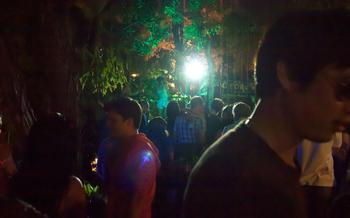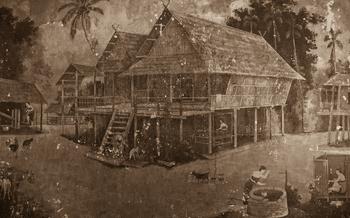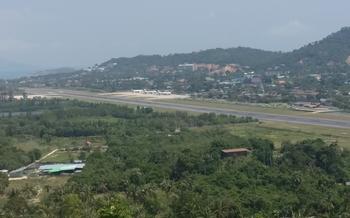
Wat Bang Non
- Wat Bang Non: A Buddhist Temple with a Unique Charm
- Exploring the Temple Grounds: A Journey of Serenity
- The Grand Stupa: A Symbol of Reverence
- The Main Shrine Room: A Place of Worship and Devotion
- The Ordination Hall: A Center for Spiritual Transformation
- The Bell Tower: A Call to Mindfulness
- The Reclining Buddha: A Symbol of Peace and Tranquility
- The Temple's Gardens: A Haven of Beauty and Serenity
- The Monks' Quarters: A Glimpse into Monastic Life
- The Temple's Festivals and Events: A Celebration of Faith
- The Local Community: A Source of Warmth and Hospitality
- The Temple's Role in Education and Social Welfare
- Wat Bang Non in Thai History and Culture: A Symbol of Resilience
- Insider Tip: Unveiling a Hidden Gem
Wat Bang Non: A Buddhist Temple with a Unique Charm
Wat Bang Non, located in the heart of Ranong, Thailand, stands as a testament to the beauty and serenity of Buddhist architecture. Founded in the 19th century, the temple holds a significant place in the religious and cultural landscape of the region. Its intricate design and spiritual ambiance make it a must-visit destination for travelers seeking a glimpse into the essence of Thai Buddhism.
The temple's history is deeply intertwined with the local community, with stories and legends passed down through generations. Its construction was driven by a profound desire to create a sacred space for worship, meditation, and spiritual growth. Over the years, Wat Bang Non has undergone several renovations and expansions, each contributing to its unique charm and architectural grandeur.
The temple's architectural features showcase a blend of traditional Thai and contemporary design elements. The main shrine room, adorned with intricate murals and decorative carvings, exudes an atmosphere of reverence and awe. The towering stupa, a symbol of peace and harmony, stands as a focal point within the temple grounds, inviting visitors to reflect on the teachings of the Buddha.
Wat Bang Non is a living testament to the vibrant religious traditions of Thailand. Throughout the year, the temple hosts a variety of ceremonies and festivals, each with its own unique significance and symbolism. These events provide an opportunity for the local community and visitors alike to come together in celebration of their shared faith and cultural heritage.
Exploring the Temple Grounds: A Journey of Serenity
As you step through the gates of Wat Bang Non, a sense of tranquility envelops you. The temple complex is laid out in a spacious and harmonious manner, with each structure and landmark contributing to the overall serene atmosphere. Notable features include a majestic stupa, a grand shrine room, an ordination hall, a bell tower, a reclining Buddha, and beautifully landscaped gardens.
The stupa, with its intricate design and gleaming white exterior, stands as a symbol of reverence and devotion. The grand shrine room, adorned with elaborate murals and decorative elements, exudes an aura of spirituality and invites visitors to immerse themselves in worship and contemplation. The ordination hall, where young men undergo the sacred ritual of becoming monks, serves as a reminder of the temple's role in preserving Buddhist traditions.
The bell tower, with its tall, elegant structure, stands as a symbol of mindfulness and calls the faithful to prayer. The reclining Buddha, with its serene expression and peaceful posture, evokes a sense of tranquility and invites visitors to reflect on the teachings of the Buddha. The temple gardens, with their lush greenery, colorful flowers, and tranquil ponds, provide a haven of peace and serenity, inviting visitors to relax and connect with nature.
The Grand Stupa: A Symbol of Reverence
Standing tall and majestic within the temple grounds, the grand stupa at Wat Bang Non is a sight to behold. In Buddhism, stupas hold immense significance, representing the Buddha's teachings and the path to enlightenment. The architectural design of the stupa is intricate and awe-inspiring, showcasing the skill and dedication of the temple's builders. Visitors can observe the intricate carvings and embellishments that adorn the stupa, each symbol carrying a profound meaning.
Offerings of flowers, candles, and incense are often made at the stupa as a way to pay respect and seek blessings. The stupa is not only a symbol of reverence but also a reminder of the impermanence of all things. It serves as a place for contemplation and reflection, inviting visitors to let go of worldly attachments and strive for spiritual liberation.
The stupa at Wat Bang Non exudes an aura of peace and harmony, making it a popular destination for meditation and spiritual practices. Whether you are a devout Buddhist or simply seeking inner peace, the stupa provides a serene and sacred space to connect with your spiritual self.
The Main Shrine Room: A Place of Worship and Devotion
The main shrine room of Wat Bang Non is the heart of the temple, a sacred space dedicated to worship and devotion. Inside, the air is thick with the scent of incense, and the gentle glow of flickering candles illuminates the room. The walls are adorned with intricate murals depicting scenes from the life of Buddha and other Buddhist tales, adding to the serene and spiritual atmosphere.
At the center of the shrine room, a magnificent golden Buddha image sits atop an ornate altar. The statue exudes an aura of peace and tranquility, its serene expression and graceful posture inviting visitors to pause and reflect. The intricate details of the Buddha's features, from the delicate curve of his lips to the gentle folds of his robes, are a testament to the skill and devotion of the artisans who created it.
Devotees often come to the main shrine room to offer prayers, light candles, and make offerings to the Buddha. The gentle chanting of monks and the rhythmic sound of prayer bells create a soothing ambiance, fostering a sense of reverence and devotion among visitors.
When visiting the main shrine room, it is important to observe respectful behavior and dress code. Visitors should remove their shoes before entering the room and dress modestly, covering their shoulders and knees. It is also customary to bow or wai in front of the Buddha image as a sign of respect.
By immersing oneself in the tranquil atmosphere of the main shrine room, visitors can experience the deep sense of peace and devotion that permeates Wat Bang Non, making it a truly special and sacred place.
The Ordination Hall: A Center for Spiritual Transformation
The ordination hall at Wat Bang Non serves as a sacred space where young men embark on a journey of spiritual transformation, becoming monks or novices in the Buddhist tradition. Here, they undergo a solemn ceremony that marks their commitment to the monastic life and the principles of Buddhism.
During ordination ceremonies, the candidates, dressed in white robes, present themselves before a gathering of monks and the temple community. Chants and prayers fill the air as they pledge to uphold the Buddhist precepts and dedicate themselves to a life of simplicity, compassion, and service.
The ordination hall is not only a place of initiation but also a center for spiritual guidance and learning. Monks and novices reside in the temple, devoting their lives to studying Buddhist scriptures, practicing meditation, and offering teachings to the community.
Through ordinations, Wat Bang Non plays a vital role in preserving and transmitting the Buddhist tradition to future generations. These ceremonies symbolize the continuity of the monastic lineage and the ongoing quest for spiritual enlightenment.
The Bell Tower: A Call to Mindfulness
Wat Bang Non's bell tower stands as a symbol of timelessness, inviting visitors to immerse themselves in the temple's serene ambiance. Constructed according to traditional Thai architectural principles, the bell tower exudes an aura of tranquility and reverence. Its towering structure, adorned with intricate carvings and gleaming spires, beckons visitors to discover the profound significance of the bell's melodious chimes.
The bell-ringing practice at Wat Bang Non holds deep cultural and spiritual significance. Each morning and evening, the rhythmic sound of the bell reverberates throughout the temple grounds, signaling the start and end of the monks' daily prayers. The bell's sonorous tone serves as a reminder to the monks and visitors alike to be mindful of the present moment and to let go of worldly distractions.
Beyond its practical purpose, the bell tower also carries symbolic meaning. In Buddhism, the sound of the bell is believed to possess the power to ward off evil spirits and negative energies. It is said that the vibrations created by the bell can purify the surrounding environment and bring peace and harmony.
The bell tower at Wat Bang Non is not merely a structure but a living testament to the temple's enduring spiritual legacy. Its presence invites visitors to pause, reflect, and reconnect with their inner selves, fostering a sense of tranquility and mindfulness that lingers long after their departure.
The Reclining Buddha: A Symbol of Peace and Tranquility
The reclining Buddha, a revered figure in Buddhism, exudes an aura of serenity and peace at Wat Bang Non. This colossal statue, crafted with intricate detail, invites visitors to immerse themselves in its symbolic significance. The posture of the reclining Buddha, with its elongated form and graceful curves, represents the moment of transition between life and death, a state of ultimate detachment and liberation.
Measuring several meters in length, the statue is a testament to the temple's commitment to preserving and honoring Buddhist traditions. The intricate carvings adorning the Buddha's robe, the serene expression on its face, and the skillful depiction of its physical features all contribute to the statue's captivating presence.
The reclining Buddha is a powerful symbol of peace and tranquility within the temple grounds. Its serene posture and benevolent gaze inspire visitors to contemplate the impermanence of life and embrace the teachings of the Buddha. It serves as a reminder to let go of worldly attachments, cultivate inner peace, and strive for spiritual enlightenment.
Visitors are invited to sit in quiet contemplation before the reclining Buddha, allowing its peaceful energy to wash over them. The statue's presence encourages reflection on the nature of existence, the cycle of life and death, and the pursuit of a path that leads to lasting happiness and liberation.
The Temple's Gardens: A Haven of Beauty and Serenity
Nestled amidst the temple complex, the gardens of Wat Bang Non offer a tranquil oasis for visitors seeking peace and serenity. Lovingly maintained by the monks, the gardens showcase a diverse array of plants, flowers, and trees, each contributing to a harmonious and vibrant ecosystem.
The layout of the gardens is carefully designed to create a sense of tranquility and balance. Visitors can stroll along winding paths, admiring the lush greenery and colorful blooms. Whether seeking a quiet spot for meditation or simply to relax and soak in the beauty of nature, the gardens provide the perfect sanctuary.
The gardens are not merely a visual feast but also a symbol of the temple's commitment to harmony between nature and spirituality. The monks believe that the natural world is sacred and that caring for the environment is an essential part of their religious practice.
As visitors wander through the gardens, they may encounter monks engaged in meditation or tending to the plants. These moments offer a glimpse into the monks' daily lives and their deep connection to the natural world.
The Monks' Quarters: A Glimpse into Monastic Life
The monks' quarters at Wat Bang Non provide a glimpse into the daily lives of the monks who reside at the temple. These quarters are typically simple and modest, reflecting the Buddhist principles of detachment and renunciation. Visitors may have the opportunity to observe the monks engaged in their daily routines, such as chanting, meditation, and studying Buddhist scriptures.
It is important to respect the privacy of the monks and to observe proper etiquette when visiting their quarters. Visitors should speak softly and avoid disturbing the monks during their meditation or study sessions. It is also important to dress respectfully and to refrain from touching or photographing the monks without their permission.
By observing the monks' quarters, visitors can gain a deeper understanding of the monastic life and the dedication of the monks to their spiritual practice. The monks' quarters serve as a reminder of the importance of discipline, devotion, and simplicity in the Buddhist tradition.
The Temple's Festivals and Events: A Celebration of Faith
Wat Bang Non is not just a place of worship but also a vibrant center for religious and cultural celebrations. Throughout the year, the temple hosts a variety of festivals and special events that draw devotees and visitors from near and far.
The most significant festival is the annual temple fair, held during the Songkran festival in April. This lively event features colorful processions, traditional Thai dancing, and a bustling market filled with food stalls, games, and local handicrafts.
Another important festival is Visakha Bucha, which commemorates the birth, enlightenment, and passing of Lord Buddha. During this festival, the temple organizes special ceremonies, chanting, and meditation sessions, offering devotees an opportunity to reflect on the teachings of the Buddha and deepen their spiritual connection.
Loy Krathong and Yi Peng are two other popular festivals celebrated at Wat Bang Non. Loy Krathong involves floating beautifully decorated krathongs (lotus-shaped boats) on the river, while Yi Peng involves releasing sky lanterns into the night sky. These festivals are a time of joy, celebration, and the renewal of good fortune.
Participating in these festivals is a wonderful way to immerse yourself in Thai culture and witness the deep devotion of the local community. Whether you join in the lively processions, savor the delicious temple fair food, or simply observe the serene ceremonies, you'll gain a deeper understanding of Thai Buddhism and the rich traditions of Wat Bang Non.
The Local Community: A Source of Warmth and Hospitality
Visiting Wat Bang Non offers an opportunity to connect with the welcoming local community that surrounds the temple. Visitors are often greeted with warm smiles and friendly greetings, making them feel like honored guests. The local people take pride in their temple and are eager to share its history, traditions, and cultural significance with visitors.
Engaging with the local community provides a chance to learn about Thai customs and traditions firsthand. Visitors can observe daily life in the temple, witness the monks' routines, and participate in conversations with the locals. The local people are happy to answer questions and share their experiences, fostering a sense of cultural exchange and understanding.
The warmth and hospitality of the local community add to the overall charm and appeal of Wat Bang Non. Visitors can feel a sense of belonging and connection as they interact with the friendly locals, creating lasting memories and a deeper appreciation for Thai culture and Buddhism.
The Temple's Role in Education and Social Welfare
Wat Bang Non plays an active role in education and social welfare, extending its reach beyond religious practices. The temple houses a school that provides free education to children from the local community, instilling in them the values of compassion, discipline, and academic excellence. It also runs a community center that offers various programs and activities, such as vocational training, healthcare services, and counseling, to support the well-being of the local residents.
The temple's commitment to social welfare is evident in its outreach initiatives, which include providing food and shelter to the needy, organizing medical camps, and supporting environmental conservation projects. Through these efforts, Wat Bang Non serves as a beacon of hope and support for the community, fostering a sense of unity and resilience among its members.
Wat Bang Non in Thai History and Culture: A Symbol of Resilience
Wat Bang Non stands as a testament to the resilience and perseverance of the Thai people. Throughout its long history, the temple has faced numerous challenges, including natural disasters, political upheavals, and wars. However, it has always emerged stronger, thanks to the unwavering dedication of its monks and the support of the local community.
One of the most remarkable examples of the temple's resilience is its survival during the Second World War. In 1942, Ranong was occupied by the Japanese, who attempted to destroy the temple and its surrounding buildings. However, the monks and villagers refused to cooperate, and they managed to protect the temple from destruction.
After the war, Wat Bang Non played a vital role in the reconstruction of Ranong. The monks provided food, shelter, and spiritual guidance to the war-torn community, and they helped to rebuild the town's infrastructure. The temple also became a center for education and culture, as the monks established a school and a library for the local children.
Today, Wat Bang Non continues to be a symbol of resilience and perseverance. It is a place where people from all walks of life can come to find peace, solace, and inspiration. The temple is also a reminder of the importance of community and the power of faith in the face of adversity.
Insider Tip: Unveiling a Hidden Gem
Beyond the main attractions of Wat Bang Non, there's a world of hidden gems waiting to be discovered. Venture into the surrounding area, and you'll find a cluster of smaller, equally enchanting temples, each with its unique charm and history. Take the time to explore these lesser-known treasures, and you'll be rewarded with a deeper appreciation for the region's rich spiritual heritage.
Engage with the resident monks, and you'll be granted a rare glimpse into the world of Buddhism. Ask questions, seek their guidance, and immerse yourself in their teachings. The monks are a fountain of knowledge, eager to share their insights and experiences. Through these interactions, you'll gain a profound understanding of Buddhist philosophy and its relevance to modern life.
To fully embrace the temple's vibrant culture, plan your visit to coincide with one of the many festivals or events held throughout the year. These celebrations are a kaleidoscope of colors, music, and traditions, offering a unique opportunity to connect with the local community and experience Thai culture at its most authentic.
And while you're exploring the temple grounds, don't forget to savor the delicious local cuisine. The area surrounding Wat Bang Non is renowned for its culinary delights, from mouthwatering seafood to exotic tropical fruits. Indulge in the flavors of Thailand and complete your temple experience with a feast for your senses.





